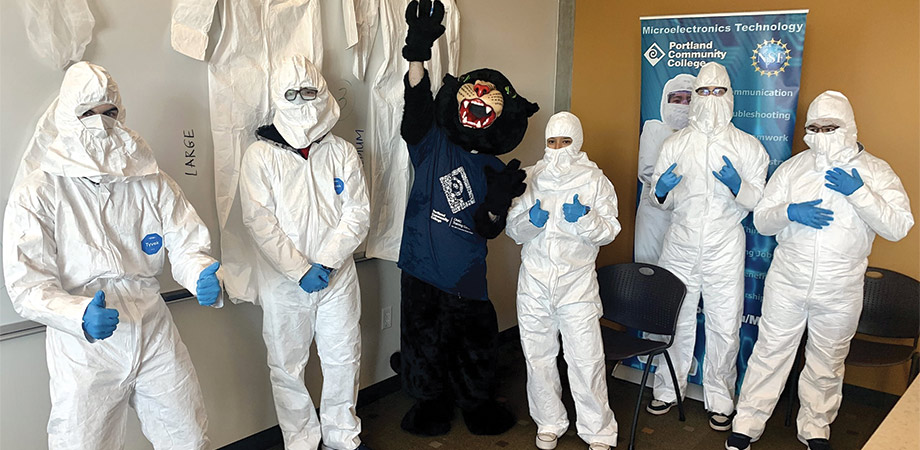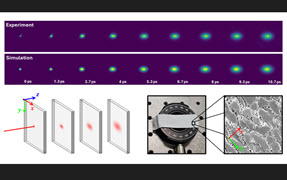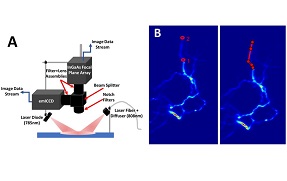SPIE Catalyst Award finalists Intel, Thorlabs, and Ball Aerospace showcase EDI, outreach, sustainability programs

This year, in addition to the regular slate of industry-focused SPIE Prism Awards — in areas ranging from healthcare and sensing to lasers and quantum — SPIE is introducing the SPIE Catalyst Award. This new recognition honors for-profit companies and their specific social or environmentally focused programs, programs that offer significant positive impact, either within the workplace, on society at large, or on the environment. Finalists for the inaugural Catalyst Award in 2024 were Ball Aerospace, Intel Corporation, and Thorlabs for consideration in one (or, in Intel’s case, two) of three categories: Equity, Diversity, Inclusion, and Accessibility; Community engagement, Outreach, Education, and Training; and Environmental Sustainability. At the SPIE Prism Awards in January, Intel was declared the inaugural winner of the SPIE Catalyst Award.
Intel
To address expected semiconductor engineering and manufacturing worker shortages — per McKinsey & Company, official estimates project a shortage of some 300,000 engineers and 90,000 technicians in the US by 2030 — and to meet Intel’s 2030RISE goal of increasing the organization’s representation of women in technical positions to 40 percent, Intel has developed two innovative and inclusive semiconductor workforce development programs, QuickStart and Returnships. Together, they aim to remove barriers to entry and re-entry into industry, while creating a larger, more diverse and inclusive workforce. Both the Quick- Start semiconductor-technician training program and the career return-ship “Relaunch” programs offer diversity-aware access to potential high-growth careers, incorporating new pipelines for training and engaging key talent.
The QuickStart program partners with local community colleges near Intel’s Oregon and Arizona factories to prepare students for entry-level technician positions. The ten-day courses emphasize small class sizes and hands-on training; having completed these courses, students are prepared to interview for entry-level manufacturing technician positions at Intel or other advanced-manufacturing companies. The program also works with local workforce and community groups to recruit and train people historically underrepresented in the technology industry, including women, people of color, veterans, people with disabilities, and people from low-income and rural communities.
Addressing the anticipated engineering shortage, the relaunch program targets experienced hires who have had a career break — perhaps through caregiving or military service — and re-integrates them over an approximate 16-week period, removing potential barriers to a smooth return to employment. This program, too, provides training and experiences to members of the community who may otherwise be overlooked by traditional hiring practices. The majority of returners are offered a full-time position at Intel at the the end of their 16-week reintegration; even if they are not offered a position, the express goal is that this enhanced training experience could ultimately help them obtain work at another company. As part of Intel’s application statement makes clear, increasing the quantity, quality, and diversity of those who can see themselves in advanced manufacturing is imperative to address the expected industry shortfalls.
“Being named a finalist for the SPIE Catalyst Award is both an honor and a testament to Intel’s unwavering commitment to building a more inclusive advanced manufacturing ecosystem by increasing awareness and accessibility to advanced manufacturing as a high wage, fulfilling career,” noted Intel Business Operations Manager, Technology Development, Diane Vidmantas. “This acknowledgment reflects Intel’s dedication to collaborate within our community to inspire more women and underrepresented minorities to pursue and succeed in technology careers which ultimately contributes to a world where diversity is a driving force for innovation and progress.”
Thorlabs

The Thorlabs Mobile Lab Experience was featured on the exhibit floor at Photonics West. Credit: Thorlabs.
Launched in 2023, the Thorlabs Mobile Lab Experience brings a fully functional photonics lab to high schools, colleges, and universities all over the US with the goal of educating students and communities on the importance of the photonics industry and fundamentals of light. The peripatetic lab will highlight advanced topics in photonics by curating a variety of interactive experiences, hoping to generate excitement and curiosity in learners of all generations.
The program aims to democratize photonics outreach and education, while also building curriculum that engages new learners as well as appealing to those working in more advanced photonics research settings. While visiting dozens of schools and universities, the program will also focus on locations and communities where access to photonics learning may be limited. With its travels underway, the lab has already fostered connections with hundreds of aspiring photonics technicians and scientists, generating increased interest in optics technology and engineering programs. As they interact with more communities on their travels, the lab managers will continue to develop experiential-rich content and hands-on lab work to educate students on the importance of photonics in daily lives, inspiring the next generation of photonics professionals.
The Thorlabs mobile lab program takes a multifaceted approach:
- Encouraging curiosity through an interactive introduction to photonics, including the areas of spectroscopy, biomedical optics, optical communications, and optical fiber technologies, drawing the connection between everyday phenomena and photonics concepts and encouraging an early appreciation of the subject.
- Hands-on c ourses a re d esigned t o facilitate a seamless transition from theory to practice, cultivating a skilled workforce equipped with the expertise required to handle sophisticated photonics setups for both academia and industry.
- Building foundational knowledge and a strong conceptual framework — ideally leading to further innovations — by exploring the basics of photonics systems such as fiber processing and optical coherence tomography. “The Thorlabs Mobile Lab Experience is the realization of a long-standing idea conceived by our founder and CEO Alex Cable,” notes Thorlabs Vice President of Sales and Business Development Michael Mohammadi.
“The mobile lab represents just the beginning of our efforts; we are curating a series of Thorlabs Experiences aimed at fostering learning, education, career paths, and the development of the photonics community. We recognize the significant role that Thorlabs plays in our industry and see these experiences as our way of helping to build awareness for our industry and helping to better prepare the photonics workforce of the future. The enthusiasm and engagement of the students who have participated in the lab experience have confirmed that our mobile lab offers a unique learning experience for students across our industry, and our nomination for SPIE Catalyst Award further validates the substantial time and resources we've invested in this project from a photonics-industry perspective.”
Ball Aerospace

Pollution-monitoring space hardware. Credit: Ball Aerospace.
According to the World Health Organization, outdoor air pollution causes 4.2 million premature deaths a year, making reliable, regular, and frequent pollution measurements key to global health and well-being. With their Geostationary Environmental Monitoring Spectrometer (GEMS) and Tropospheric Emissions: Monitoring of Pollution (TEMPO) technologies, Ball Aerospace has created two geostationary ultraviolet/ visible spectrometers that provide regional, hourly, high-spatial resolution measurements of atmospheric elements critical to understanding air pollution — ozone, nitrogen dioxide, sulfur dioxide, formaldehyde, and aerosols — during daylight hours. By measuring air quality over large geographical areas and providing unparalleled insight into the quality of the air we breathe, these instruments offer an opportunity to take informed action that will improve people’s health and well-being: by giving governments, businesses, and individuals the data they need to make informed decisions about air quality, stakeholders and communities can work together to create a healthier, more sustainable world for future generations.
GEMS and TEMPO are electro- optical sensors consisting of a hyperspectral, UV/Vis imaging spectrometer, telescope, and precision pointing devices that make high-quality measurements of Earth’s radiance that can be transformed into environmental measurements. TEMPO launched on April 7, 2023, from Cape Canaveral Space Force Station as part of NASA’s Earth Venture Instrument program. On August 24, 2023, the TEMPO instrument released its first images spanning greater North America. Now that the instrument is active, the TEMPO team is busy validating its spatial, spectral, and radiometric performance, as well as the science data processing chain. Once this process is complete, members of the public and the scientific community will have access to near real-time information, packaged by the Center for Astrophysics, a collaboration between the Harvard College Observatory and the Smithsonian Astrophysical Observatory, and distributed by NASA. GEMS, which provides similar data from across Southeast Asia, was launched in 2020 as part of an air-quality monitoring mission for the South Korean National Institute of Environmental Research.
A few examples of the potential impact of this satellite technology:
- With access to hourly air pollution data around the globe, scientists can identify problem areas, empowering local groups to implement effective solutions and build resilience that reduces harmful emissions and improves air quality.
- According to the American Lung Association, more than 4 in 10 Americans live in places with unhealthy levels of air pollution. In the past, the world’s ability to mitigate poor air quality and the damage it causes was hampered by a lack of actionable information. The data GEMS and TEMPO provide will close this gap. The data will also help with epidemiological studies related to air quality.
- According to Harvard’s School of Public Health, poor air quality inordinately impacts low-income communities due to a lack of emissions regulations and disproportionate placement of pollution sources nearby low-income neighborhoods. GEMS and TEMPO will help scientists identify regions that are most heavily impacted by poor air pollution, influencing regulatory changes to create healthier air for all.
- Atmospheric emissions of pollutants end up in our streams, lakes, and other natural bodies of water. The ability to better track and quantify emissions will assist in understanding pollutant loads into our hydrologic systems.
“Our team is thrilled to be included among the finalists for this new Catalyst Award, and to be recognized alongside such a remarkable group of innovators in the field,” said Alberto Conti, vice president and general manager, Civil Space, Ball Aerospace. “We’re confident this nomination will focus even more attention on the vital work we, our customers, and our partners are doing with GEMS and TEMPO to further highlight the importance of these groundbreaking pollution monitoring tools.”
From providing a path toward improving global health to scaling up the process of building a reliable and robust optics and photonics workforce, all three of these SPIE Catalyst Award finalists are shining an exciting light on a variety of possibilities by putting them into tangible and impactful action.
This article was originally published in the Photonics West Show Daily in January 2024.
| Enjoy this article? Get similar news in your inbox |
|



